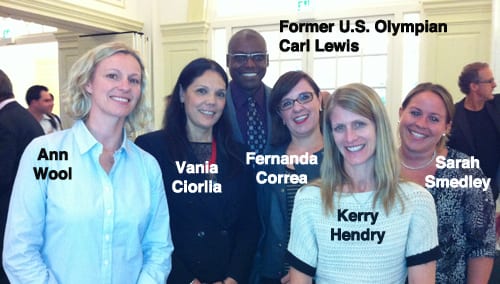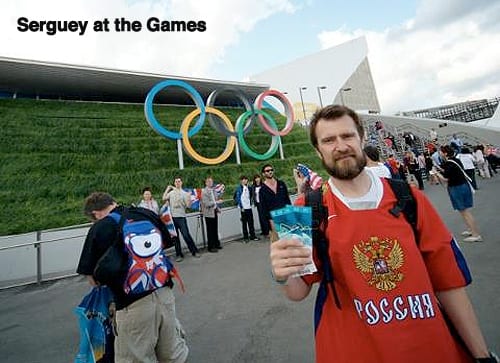The Olympics may be over, but the buzz the Games created worldwide is still being felt. It was a remarkable event for media and communications: the first time the Olympics were broadcast via live streaming, the highest-ever TV ratings across a variety of categories, the world’s most heavily policed event for brands… the list of superlatives goes on.
Many colleagues from Ketchum were lucky enough to attend the Games in London both for work and for pleasure. They took some time to share some insights and observations about what struck them on the ground from a PR perspective. Here are some of their thoughts.
Vania Ciorlia, Executive Director, KSE, Brazil, and Fernanda Correa, Strategic Planning and Creative Director, Ketchum Brazil

We attended the Olympics on behalf of Ketchum Sports and Entertainment (KSE), and the most important trends we observed were:
- Mixed Digital and Print Content: It was just as common to see people on their mobiles, searching online and orienting themselves with geolocation, as it was to see them referring to printed maps and leaflets with transportation routes. When you are abroad, information has to be at your fingertips, no matter where it comes from – especially when mobile devices don’t have more than three hours’ worth of juice. Supplementing this was an army of Olympic volunteers with iPads who could tell you everything you needed to know.
- Ubiquity of Social Media: Every attraction was linked to social media. At museums, pavilions, stands and other locations, we were encouraged to sign up using an iPad, and every interaction could be automatically reflected on Facebook, Twitter or email. We could even “like” things in real time by scanning QR codes.
- Creating Experiences Through Branded Content: Sponsors such as Acer, BP, Coca-Cola, Samsung and EDF created branded pavilions at the Olympic Park. The best brand experiences focused on entertainment and exploring the senses. Less successful were those that took a corporate approach and tried to promote their business to a sports audience. After all, Olympics tourists are there for joy and fun, not to be sold to.
Serguey Chumin, Partner and Financial Director, Ketchum Maslov
 This year, I was able to share the spirit and the inspiration with my family by visiting the Games together. We were definitely inspired – we attended the opening ceremony, saw seven events in five venues and supported the Russian team throughout. London did it all with the grace and dignity.
This year, I was able to share the spirit and the inspiration with my family by visiting the Games together. We were definitely inspired – we attended the opening ceremony, saw seven events in five venues and supported the Russian team throughout. London did it all with the grace and dignity.
From a media perspective, I was amazed how unified the supporting crowd and the press were when it came to Team Great Britain – it was impossible to find anything about any other team on TV or in the press. Personally, I was glad to see just a sleeve of a Russian champion in one photo – but that was a part of the fun.
Juliette Terrazas, research director, New York
 When I received my Olympics tickets in the mail (I went for fun, not for work), they came with items from key sponsors:
When I received my Olympics tickets in the mail (I went for fun, not for work), they came with items from key sponsors:
- A tag from BP with a website address where I could type in my code and off-set the carbon footprint of my travel to the Games. Many of the tags had pictures of Olympic athletes from Britain’s Team GB, making it a nice way to show support for the team while pushing sustainability messaging.
- A Team GB supporters’ sticker from Lloyds TSB. The sticker described how, by uploading a photo to their Facebook page, I could win a chance to attend the Team GB celebration party.
Apart from that, as a researcher, it was heartening to get an email with a link to a questionnaire about my Olympics experience. It came at the end of my day at the Olympics – very timely and great to see them looking to glean insights about what worked and didn’t.
Emily Schmidt, Senior Account Executive, San Francisco
Despite the crowded (and fatigue-inducing) barrage of corporate ads splashed across venue backdrops, woven into commentator messaging and featured in Super Bowl-style commercials, there was one notorious Olympic trademark that couldn’t be branded or sponsored – the athletes’ victory celebrations.
From “crip walks” to “the worm,” athletes share their joy in a variety of quirky dance moves. Some of the victory moves, such as the infamous Jamaican lightning bolt by sprinter Usain Bolt, even go viral with spectators (including Prince Harry) imitating the dance moves around the world. The best victory dance of the London 2012 games? Without a doubt – NBA star LeBron James after winning gold for the U.S. men’s basketball team.
With millions of dollars pouring into the Olympics to drive brand visibility, victory dances remain athletes’ authentic and FREE secret weapon to drive their own visibility in a very crowded landscape. If we can somehow find a way to harness a victory dance to promote a client initiative during the 2016 Rio games – now that would be real “victory move.”


